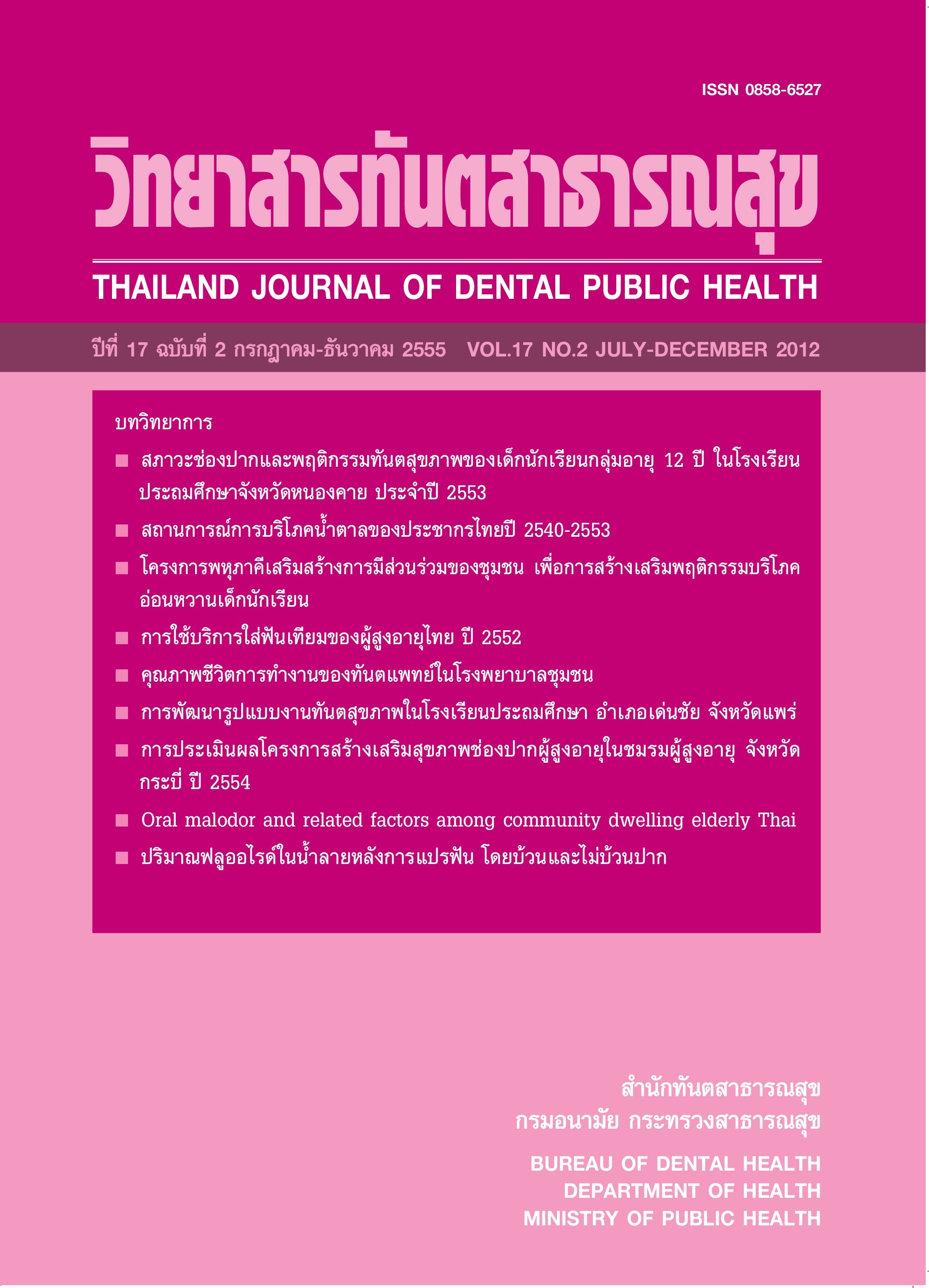Oral malodor and related factors among community dwelling elderly Thai
Main Article Content
Abstract
Aim: The purpose of this study to examine the oral malodor and relationship of oral malodor with socio-demographic factors, oral health behavioral and oral health status in community-dwelling elderly Thai.
Material and Methods: The subjects were 612 elderly (158 males and 454 females; mean age = 68.8 SD= 5.9) who lived in Maung, Phitsanulok, Thailand. Oral malodor was measured by the organoleptic method and using oral ChromaTM. The socio-demographic and oral health behavioral characteristics were investigated by a questionnaire. Oral examination including teeth and periodontal conditions were examined. Salivary flow rate were measured.
Results: Prevalence of oral malodor diagnosed by the organoleptic method was 64.7%. Logistic regression showed that the risk factors related to oral malodor were level of education (OR=1.58), dental visit behaviors ((OR=1.68), deep pockets (OR=2.95), gingival bleeding (OR=2.47), tongue coating (OR=58.36), salivary flow rate (OR=1.77) and pH of saliva (OR=1.26).
Conclusion: There was a high prevalence of oral malodor, which was associated with oral health and behavioral factors in community dwelling elderly Thai. The effective treatment of periodontal disease, improvement of oral hygiene condition and appropriate oral health education are all important to ameliorate oral malodor and improve oral health of the elderly.
Downloads
Article Details
References
2. Scully C, Greenman J. Halitosis (breath odor). Periodontol 2000. 2008;48:66-75.
3. Delanghe G, Ghyselen J, van Steenberghe D, Feenstra L. Multidisciplinary breath-odour clinic. Lancet. 1997 Jul 19;350(9072):187.
4. Tangerman A, Winkel EG. Intra- and extra-oral halitosis: finding of a new form of extra-oral blood-borne halitosis caused by dimethyl sulphide. J Clin Periodontol. 2007 Sep;34(9):748-55.
5. van den Broek AM, Feenstra L, de Baat C. A review of the current literature on management of halitosis. Oral Dis. 2008 Jan;14(1):30-9.
6. Quirynen M. Management of oral malodour. J Clin Periodontol. 2003;30 Suppl 5:17-8.
7. Murata T, Yamaga T, Iida T, Miyazaki H, Yaegaki K. Classification and examination of halitosis. Int Dent J. 2002 Jun;52 Suppl 3:181-6.
8. Wozniak WT. The ADA guidelines on oral malodor products. Oral Dis. 2005;11 Suppl 1:7-9.
9. Donaldson AC, Riggio MP, Rolph HJ, Bagg J, Hodge PJ. Clinical examination of subjects with halitosis. Oral Dis. 2007 Jan;13(1):63-70.
10. Lee PP, Mak WY, Newsome P. The aetiology and treatment of oral halitosis: an update. Hong Kong Med J. 2004 Dec;10(6):414-8.
11. Murata T, Rahardjo A, Fujiyama Y, Yamaga T, Hanada M, Yaegaki K, et al. Development of a compact and simple gas chromatography for oral malodor measurement. J Periodontol. 2006 Jul;77(7):1142-7.
12. Soder B, Johansson B, Soder PO. The relation between foetor ex ore, oral hygiene and periodontal disease. Swed Dent J. 2000;24(3):73-82.
13. Bornstein MM, Stocker BL, Seemann R, Burgin WB, Lussi A. Prevalence of halitosis in young male adults: a study in swiss army recruits comparing self-reported and clinical data. J Periodontol. 2009 Jan;80(1):24-31.
14. Khaira N, Palmer RM, Wilson RF, Scott DA, Wade WG. Production of volatile sulphur compounds in diseased periodontal pockets is significantly increased in smokers. Oral Dis. 2000 Nov;6(6):371-5.
15. Yaegaki K, Coil JM. Diagnosis of halitosis by utilizing questionnaire and organoleptic measurement. Quintessence 1999; 18:745-53.
16. World Health Organization. Oral health surveys: basic methods. 4th edition,199
17. Oho T., Yoshida Y., Shimazaki Y., Yamashita Y., Koga T.. Characteristics of patients complaining of halitosis and the usefulness of gas chromatography for diagnosing halitosis. Oral Surgery Oral Medicine Oral Pathology Oral Radiology and Endodontics 2001; 91:531-534.
18 Bergdahl M. Salivary flow and oral complaints in adult dental patients. Community Dentistry and Oral Epidemiology 2000; 28(1):59-66.
19. Miyazaki H, Sakao S, Katoh Y, Takehara T. Correlation between volatile sulphur compounds and certain oral health measurements in the general population. J Periodontol. 1995 Aug;66(8):679-84.
20. Al-Ansari JM, Boodai H, Al-Sumait N, Al-Khabbaz AK, Al-Shammari KF, Salako N. Factors associated with self-reported halitosis in Kuwaiti patients. J Dent. 2006 Aug;34(7):444-9.
21. Rayman S, Almas K. Halitosis among racially diverse populations: an update. Int J Dent Hyg. 2008 Feb;6(1):2-7.
22. Bosy A, Kulkarni GV, Rosenberg M, McCulloch CA. Relationship of oral malodor to periodontitis: evidence of independence in discrete subpopulations. Journal of Periodontology 1994;65(1):37-46.
23. Morita M, Wang HL. Relationship between sulcular sulfide level and oral malodor in subjects with periodontal disease. Journal of Periodontology 2001; 72(1):79-84.
24. Yaegaki K, Sanada K. Biochemical and clinical factors influencing oral malodor in periodontal patients. Journal of Periodontology 1992; 63(9):783-9.
25. Lee C.H., Kho H.S., Chung S.C., Lee S.W., Kim Y .K. The relationship between volatile sulfur compounds and major halitosis-inducing factors. Journal of Periodontology. 2003; 74:32-37.
26. Hinode D., Fukui M., Yokoyama N., Yoshioka M., Nakamura R. Relationship between tongue coating and secretory-immunoglobulin A level in saliva obtained from patients complaining of oral malodor. Journal of Clinical Periodontology 2003; 30:1017-1023.
27. Cicek Y., Orbak R., Tezel A., Orbak Z., Erciyas K. Effect of tongue brushing on oral malodor in adolescents. Pediatrics International 2003; 45:719-723
28. Awano, S., Gohana, K., Kurihara, E., Ansai, T., Takahara, T. The relationship between the presence of periodontopathogenic bacteria in saliva and halitosis. International Dental Journal 2002; 52;212-216
29. Tonzetich J, Coil JM, Ng W. Gas chromatographic method for trapping and detection of volatile organic compounds from human mouth air. The Journal of Clinical Dentistry 1991; 2(3):79-82.
30. Koshimune S, Awano S, Gohara K, Kurihara E, Ansai T, Takehara T. Low salivary flow and volatile sulfur compounds in mouth air. Oral Surg Oral Med Oral Pathol Oral Radiol Endod. 2003 Jul;96(1):38-41.
31. Kleinberg I, Westbay G. Oral malodor. Crit Rev Oral Biol Med. 1990;1(4):247-59.
32. Waler SM. On the transformation of sulfur-containing amino acids and peptides to volatile sulfur compounds (VSC) in the human mouth. Eur J Oral Sci. 1997 Oct;105(5 Pt 2):534-7.


